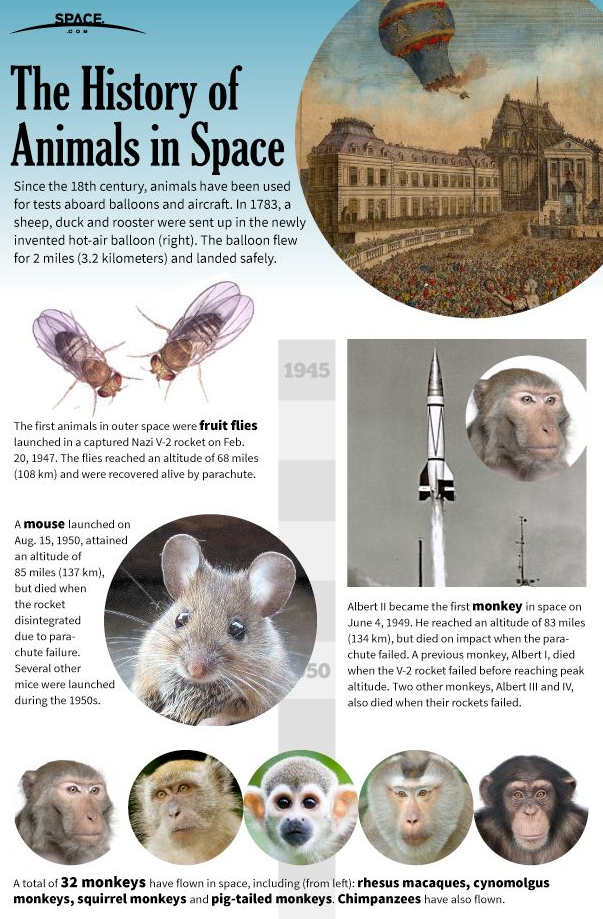Which Was The First Animal in Space
Written by Manya Pandey, a first-year undergraduate student.
Fruit flies went to space before any other humans – they were actually the first living things in space!
Written by Manya Pandey, a first-year undergraduate student.
Here’s a super interesting space fact – fruit flies went to space before any other humans – they were actually the first living things in space!
Why animals in space?
Space had to be tried and tested before humans could be sent there – since we needed to understand the effects of space travel on living beings before people could go in.
This is why scientists thought it would be best to send some other mammals to check the survivability (of the space shuttle) and to check other unforeseeable factors in take-off and landing. It was not a new move considering how medicines and cosmetics are first tested on lab rats and guinea pigs before manufacturing for human consumption.
To date, seven national space programs have flown animals into space – namely the Soviet Union, United States, France, Argentina, China, Japan, and Iran.
Which animals have gone to space?
A wide variety of animals have been launched into space, including monkeys, dogs, cats, tortoises, mice, rats, rabbits, fish, frogs, spiders, and our closest ancestors apes.
Here’s a great infographic that shows this….

The United States began launching primates (monkeys) closer to stars between 1948 and 1985.
Tortoises and many different insects became the first inhabitants of Earth to circle the Moon, on the 1968 Zond 5 mission.
France also launched two monkey-carrying flights in 1967, and The Soviet Union followed shortly after. In fact, the Soviet space program launched several dogs into outer space and different orbits on Earth.
The most famous animal to visit space was a female dog named Laika. She was sent up on Nov. 3, 1957, in Sputnik, the first artificial Earth satellite launched by the Russians.
Fun fact- In 1972 five mice named Fe, Fi, Fo, Fum, and Phooey, orbited the Moon a record 75 times in Apollo 17 spacecraft.
The first animal to enter space
Space exploration began with baby steps so the first animals to see the stars and planets up close were actually a bunch of fruit flies.
They went aboard a US V-2 rocket in 1947. This experiment aimed to gather the effects of radiation at high altitudes. After the rocket crossed the internationally defined 100-kilometer boundary of space, the capsule was ejected and the flies were recovered alive.
The second animal and the first mammal in space.
A rhesus monkey named Albert II became the first monkey, the first primate, and the first mammal to ever go into space.
Albert II was launched on a similar model V-2 rocket on 14 June 1949. Albert II reached about 134 km (83 mi) but the capsule carrying him experienced a parachute failure shortly after ejection from the rocket, couldn’t survive, and died on impact after the parachute failure.
Albert, I could have been the first animal to go to space but he couldn’t cross the internally defined 100-kilometer space altitude and only reached about 48–63 kilometers.
In 2021, the American space agency, SpaceX launched tardigrades (water bears) and squids into space
Tardigrades, commonly known as water bears, are micro animals with eight legs that are found in deep seas and forests. They were launched to the International space station (ISS) in June 2021 along with Hawaiian bobtail squid for research purposes.
Why do scientists take animals into space?
Initially, scientists didn’t know if humans could survive in a space shuttle and needed to find out more before human lives could be put on the line. That’s when animals came to the rescue. These early flights with a monkey named Albert II and Laika, the space dog proved that humans could survive in high gravity and weightlessness in those days most animals sent to space didn’t survive and none of them returned from the cosmos, but they helped us improve the technology in a way that humans could be safe in space.
Animals are still sent into space for other research projects like scientists want to know how the body reacts to microgravity and while astronauts can conduct a lot of experiments on themselves but in some cases they need help, that is where animals come but fortunately they are used only when absolutely necessary.
Special training for space journey
All the cosmonauts undergo months and months of training in preparation for a space trip and so did animals. Laika, the soviet union space dog trained by learning to progressively adjust to smaller living spaces. She was spun in a centrifuge to accustom her to changes in gravitation, and learned to accept food in jellied form, the same way astronauts in training do.
Animals that are sent to space were implanted with sensors to measure vital signs such as heart rate, breathing, etc, and many were put under anesthesia (temporarily put to sleep with medicines) during launch.
Why Are Planets Round
Fun Facts About Solar Systems
Fun Facts About Neptune In 2022
Sign up for our free newsletter here

I Kid You Not now has a large readership across India and also parts of the world. If you want to write for us, you can submit your story here. You can also apply to become a news anchor. Apply here
Better Your Child’s G.K. In 3 Minutes – Get This Free Newsletter
Get fun facts, simple and easy news, quizzes, and lots of other interesting things to read in your mailbox – for free! It’s what we call GK-on-the-go!



Comments